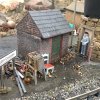Hello all..
Long, long ago, in a bedroom not too far away..
I 'built' Airfix models, and then used the equivalent of a mop in a tar bucket, to apply Airfix / Humbrol enamel paints straight from the jar / tin!
I recently bought a 'pot' of Tamiya acrylic paint, and a bottle of 'Acrylic Thinners'..
The paint is a revelation to start with! Lovely consistency, nothing like the enamels of yore..
Now, here was me expecting the paint to be the consistency of Poster-paint, and was thinking acrylic equals water-based, why do you need special thinners??
It is my intention to use 'rattle can' primers. Hopefully the Milliput I bought a while back. - Can you 'thin' that down? I think mine may be a little past-it. Then brush-paint the colour-coats.
I also have a cheap set of ?8 possibly? small tubes of acrylic paint. - These are fairly 'primary' plus black and white, of course.
Are there any 'Acrylics 101' lessons anyone can pass-on please?
Thanks
PhilP.
Long, long ago, in a bedroom not too far away..
I 'built' Airfix models, and then used the equivalent of a mop in a tar bucket, to apply Airfix / Humbrol enamel paints straight from the jar / tin!
I recently bought a 'pot' of Tamiya acrylic paint, and a bottle of 'Acrylic Thinners'..
The paint is a revelation to start with! Lovely consistency, nothing like the enamels of yore..
Now, here was me expecting the paint to be the consistency of Poster-paint, and was thinking acrylic equals water-based, why do you need special thinners??
It is my intention to use 'rattle can' primers. Hopefully the Milliput I bought a while back. - Can you 'thin' that down? I think mine may be a little past-it. Then brush-paint the colour-coats.
I also have a cheap set of ?8 possibly? small tubes of acrylic paint. - These are fairly 'primary' plus black and white, of course.
Are there any 'Acrylics 101' lessons anyone can pass-on please?
Thanks
PhilP.


